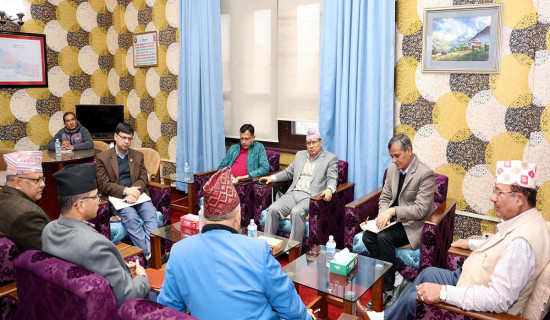- Sunday, 18 January 2026
Health Services To All
In line with Nepal’s constitutional provision of ensuring free healthcare services to citizens, the Health Insurance Scheme was introduced in 2016-17. The Health Insurance Board (HIB) has been implementing this important social security programme. As health is a multidimensional sector related basic right, it is closely linked to numerous targets of the Sustainable Development Goals (SDGs) as well. With this scheme, the government has aimed at increasing people’s access to quality healthcare services. The programme helps to prevent people from falling into poverty because of healthcare costs. It also calls for promoting quality health services and tries to address barriers in the utilisation of health services. Besides, the government seeks to ensure equity and access of the poor and disadvantaged groups and communities to health services as a means of attaining universal health coverage.
Under this scheme, a family of up to five members is required to pay a premium of Rs. 3,500 annually to get health services of up to Rs. 100,000. But a family having more than five members needs to pay Rs. 700 for each additional member. This qualifies them for an extra insurance coverage of Rs. 20,000. The government pays the premium for the poor and disadvantaged groups. Initially, the scheme, as a pilot programme, was implemented in three districts—Kailali, Baglung and Ilam. With the scheme becoming effective in delivering health services to more people at an affordable cost, the government has extended this programme nationwide. The scheme is currently being implemented in 746 local levels of all the 77 districts. As of mid-April this year, more than 5.7 million people have been covered in this scheme across the country and about 75 per cent of them have been renewing it annually.
According to a news report carried by this daily on Monday, as many as 450 health facilities located in different parts of the nation have been providing healthcare services to those enrolled in this scheme. And most public hospitals have now been offering services under this scheme as well. This scheme covers almost every health service for the participants. Under the scheme, 1,133 types of medicines are made available to them. This indicates that the scheme has been gaining ground as it has ensured people’s increased access to healthcare services. Despite being very useful to everyone, this programme has now started to face snags to meet its objectives because of the HIB’s inability to make payments to hospitals on time for the treatment of those who have been registered with this scheme. Several public, community-based and private hospitals have announced that they are postponing this programme owing to lack of timely payments from the HIB and the beneficiaries’ growing demand for extra services.
Another issue related to this scheme is that there is a growing tendency among hospitals to claim hefty amounts from the HIB by submitting fake bills. Beneficiaries also complain that hospitals do not provide prompt services to them. Rising disparity between insured and uninsured patients in hospitals, and referral-related problems are other factors behind the loss of people’s attraction towards this scheme. However, the HIB is planning to release payments to hospitals on a monthly basis from the coming fiscal year. This could help resolve the major problems. Removing all the snags facing this scheme is urgent as it is related to basic health and wellbeing of the citizens.

















